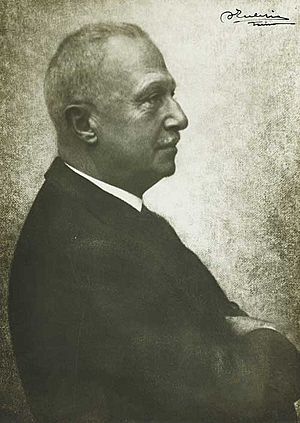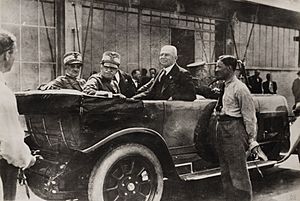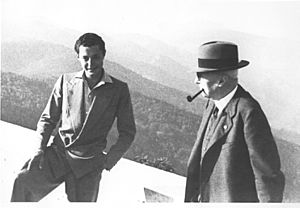Giovanni Agnelli facts for kids
Quick facts for kids
Giovanni Agnelli
|
|
|---|---|
 |
|
| Member of the Senate | |
| In office 29 May 1923 – 7 August 1944 |
|
| Monarch | Victor Emmanuel III |
| Personal details | |
| Born | 13 August 1866 Villar Perosa, Italy |
| Died | 16 December 1945 (aged 79) Turin, Italy |
| Political party | National Fascist Party |
| Spouse | Clara Boselli |
| Children | Edoardo Agnelli (1892–1935) Aniceta Caterina (1889–1928) |
| Parents | Edoardo Agnelli (1831–1871) Aniceta Frisetti (1846–1920) |
| Relatives | Gianni Agnelli (grandson) Susanna Agnelli (granddaughter) Giorgio Agnelli (grandson) Umberto Agnelli (grandson) Andrea Agnelli (great-grandson) John Elkann (great-great-grandson) |
| Education | Honorary degree in industrial engineering |
| Occupation | Businessman, politician |
| Known for | Founder of Fiat S.p.A. |
Giovanni Agnelli (born August 13, 1866 – died December 16, 1945) was an Italian businessman. He is famous for founding the Fiat S.p.A. car company in 1899.
Contents
Early Life and Family
Giovanni Agnelli was born in 1866 in Villar Perosa, a small town in Italy. His family owned land and was involved in business in Turin. His father, Edoardo Agnelli, was the mayor of Villar Perosa. Giovanni was only five years old when his father passed away.
He went to school at Collegio San Giuseppe in Turin. After finishing school, he joined the military. In 1893, Agnelli returned to his hometown. He became mayor of Villar Perosa in 1895, just like his father. He held this job for the rest of his life. After his son, Edoardo, died in 1935, Giovanni took care of his grandson, Gianni Agnelli. Gianni later became mayor after Giovanni.
In the late 1800s, Agnelli learned about the new "horseless carriage." He quickly saw a chance to use his skills in engineering and business. In 1898, he met Count Emanuele Cacherano di Bricherasio. The Count was looking for people to invest in his car project. Agnelli saw the great opportunity, and Fiat was started in 1899.
Giovanni Agnelli married Clara Boselli. They had seven children together. By the year 2000, their family had grown to include over seventy descendants.
Building the Fiat Empire
On July 11, 1899, Giovanni Agnelli helped start Fiat S.p.A.. Fiat stands for Fabbrica Italiana di Automobili Torino, which means "Italian Automobile Factory of Turin." He invested $400 to become a founding member. Just one year later, he became the managing director of the new company. In 1920, he became the chairman.
The first Fiat factory opened in 1900. It had 35 workers and made 24 cars. Fiat quickly became known for its talented engineers. By 1903, Fiat started making a profit. They produced 135 cars that year. By 1906, production grew to 1,149 cars. The company then began selling shares to the public on the Milan stock exchange. Agnelli bought as many shares as he could to increase his ownership.
During these early years, Fiat faced some challenges. There were worker strikes and other problems. Agnelli worked to solve these issues. He offered workers new contracts that linked their pay to how much they produced. This helped the company grow even during tough economic times.

During World War I, Agnelli got involved in helping transport aid from the United States to Europe. He invested in companies that exported coal and built ships. These businesses did very well during the war. However, they struggled once the war ended because they were built for wartime needs.
In the early 1920s, Agnelli became the main owner of Fiat. He helped another businessman, Riccardo Gualino, with his textile fiber company. In return, Agnelli received more Fiat shares. This made him the biggest shareholder by 1927.
After World War I, Fiat became one of Italy's top industrial companies. It moved from 30th place to third. The first Ford Motor Company factory opened only four years after Fiat was founded. In 1906, the first Fiat car dealer in the United States opened in New York City. Agnelli wanted Fiat to be a global company. He worked hard to make Fiat known around the world.
Agnelli and Politics
Giovanni Agnelli was appointed as a senator in 1923 by Benito Mussolini, who was the leader of the National Fascist Party. Agnelli had known Mussolini since 1914. Even though he was a senator for the Fascist party, Agnelli tried to keep his newspaper, La Stampa, separate from Mussolini's influence. He also tried to protect Fiat's independence from the government.
Agnelli was known for supporting people who were not liked by Mussolini. For example, he hired Curzio Malaparte to direct La Stampa, even though Mussolini disliked him. He also hired anti-fascist teachers for his grandsons. Agnelli was even suspected by the government of helping anti-fascist groups in the 1930s.
Mussolini once said that Agnelli was "too old to be fascist." The Fascist secret police watched Agnelli closely. There were reports that Agnelli supported people who were against the Fascist regime. He even tried to help one of his grandsons' tutors when he was arrested.
Historians say that Agnelli was not an anti-fascist himself. He believed that the Fascist government helped keep workers disciplined. He also felt it was necessary to work with the government for the good of his industry. However, he always tried to keep Fiat independent from the Fascist government's control. This desire for independence created a kind of understanding between Agnelli and the Fiat workers. This made it harder for fascism to take strong root in Turin.
Later Life and Legacy
Giovanni Agnelli was still actively involved with Fiat when World War II began. After the war ended, he was accused of working with the Fascist government. He was temporarily not allowed to own his companies. However, Fiat had always tried to stay independent from the Fascist regime. Some historians say that Fiat even helped the Italian resistance movement during the war. They provided vehicles, fuel, and money to support the movement. They also helped damage war production in their factories.
Agnelli was later cleared of the accusations. He passed away soon after, on December 16, 1945, at the age of 79. His legacy lives on through Fiat, which became one of the world's leading car manufacturers.
Honours
 Knight Grand Cross of the Order of the Crown of Italy (1932)
Knight Grand Cross of the Order of the Crown of Italy (1932) Knight of the Order of Labour (1907)
Knight of the Order of Labour (1907) Grand Officer of the Order of Saints Maurice and Lazarus (1921)
Grand Officer of the Order of Saints Maurice and Lazarus (1921)- Inducted into the European Automotive Hall of Fame in 2001.
- Inducted into the Automotive Hall of Fame in 2002.
See also
- Ceirano GB & C
 In Spanish: Giovanni Agnelli para niños
In Spanish: Giovanni Agnelli para niños


